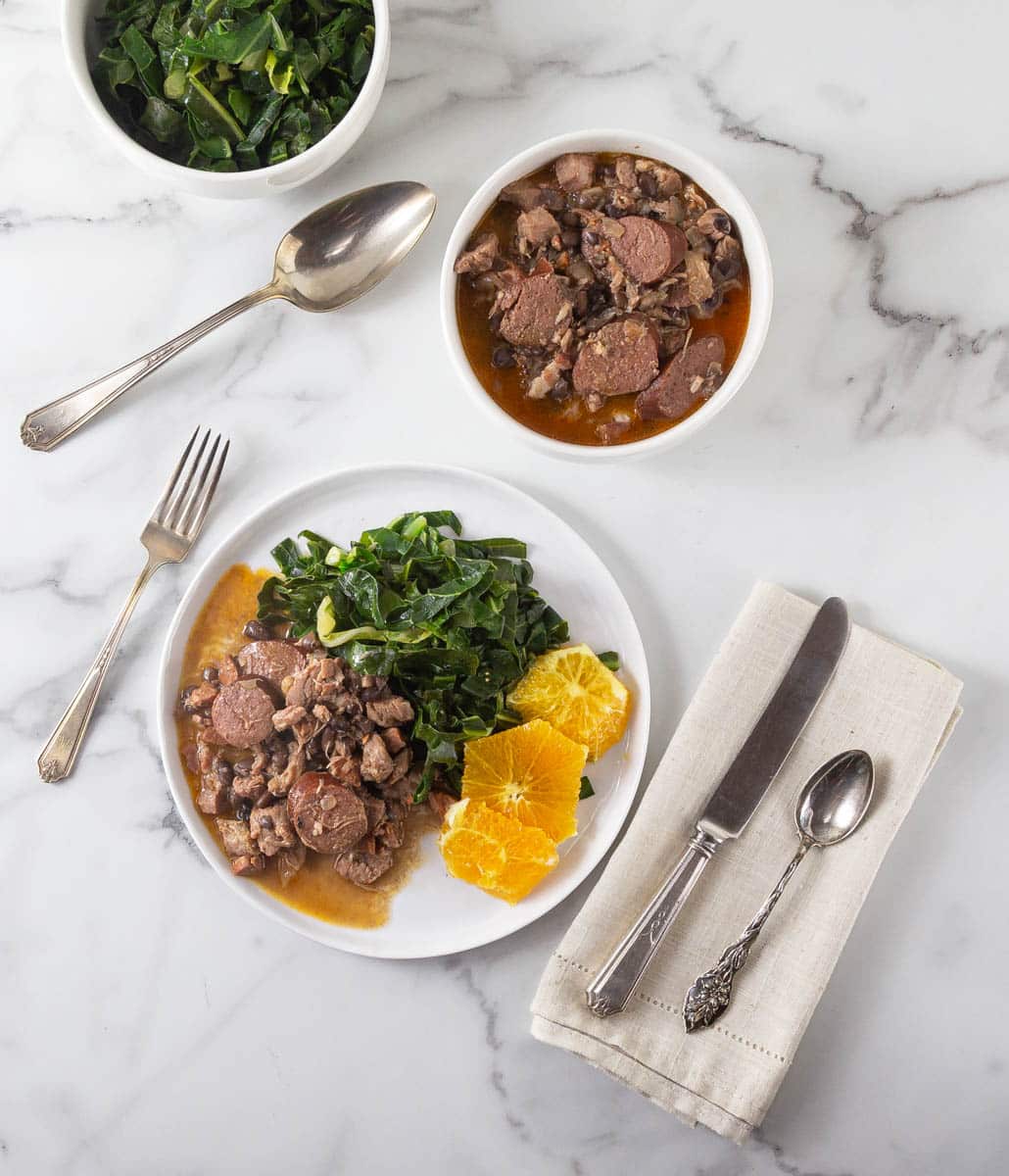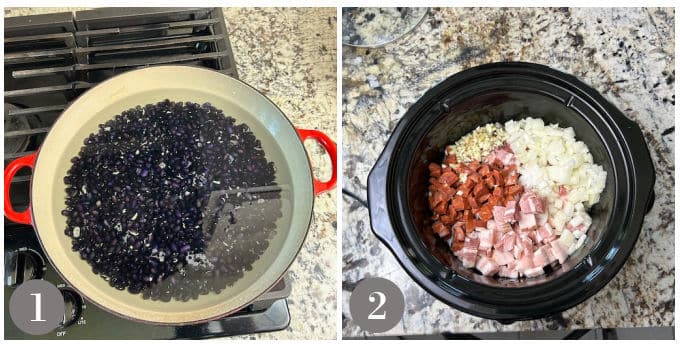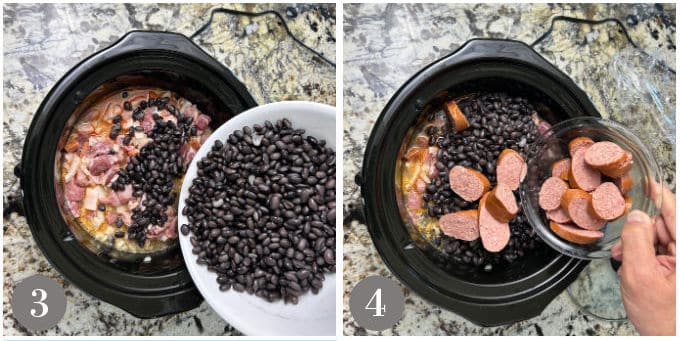This black bean stew builds layers of flavors with smoky pork, bacon, sausages and earthy black beans. You will love the combination of flavors and textures in this famous dish from Brazil.

Feijoada is a traditional Brazilian stew, often considered the country's national dish. Feijoada is usually served with rice, collard greens and orange slices. The combination of the tender beans and meat, along with the accompaniments, creates a satisfying and comforting meal that's perfect for gatherings and special occasions. It's often enjoyed on weekends and during festive events in Brazil.
This was inspired by my Cuban style black beans on this site, and pairs well with these spicy pork tacos with red cabbage slaw.
Ingredients
This dish uses simple and easy to find ingredients. There are many variations and substitutions you can try to make this dish to your taste preferences.

- Beef broth and chicken broth: This adds a rich flavor to the stew. If you don't have both broths you can always use water.
- Pork shoulder aka pork butt: I like to use a boneless pork shoulder that comes prepackaged in a 2-4 pound package. Most full sized pork shoulders are about 6-9 pound so feel free to use one of those if you are making a big batch.
- Chorizo: Get the dried or cured type and not the fresh one that needs cooked.
- Black beans: Use dry beans and soak them overnight.
- Smoked sausage: Use your favorite sausage. I like to use beef sausage that you can find at most stores.
- Bacon: I like thick pieces so any good slab bacon works nicely.
- Onion: Dice this for the stew into fine pieces about ½ inch.
- Garlic: Mince the cloves.
- Seasonings: Bay leaf, salt and black pepper.
See recipe card for quantities.
Instructions
Here are the steps to make feijoada in your slow cooker.

- Step 1: Rinse and sort the beans. Place in a large bowl and add water to cover by 2 inches. Cover them and let them soak overnight. Drain and rinse the beans then add them to a sauce pan. Add water to the pan and cover them by 2 inches of water. Bring to a boil and boil for 15 minutes. Drain and rinse after boiling then set aside.
- Add the pork, bacon, chorizo, onion, garlic, bay leaf, salt, pepper, chicken broth, beef broth and water to a 6 quart slow cooker. Cover and cook on high for 2 hours.

- Step 3: Add the beans to the slow cooker.
- Step 4: Add the smoked sausage to the slow cooker. Cover and cook on low for 5-6 hours until the pork is fall apart tender. Serve with collard greens, orange slices and white rice.
Substitutions and Variations
There a lot of flavor variations and meats you can change to your taste preferences or what you can find at your local store.
- Carne seca: Dried beef also know as beef jerkey is a popular addition. Swap out 1 pound of the pork shoulder for dried beef.
- Brazilian style sausages: Exchange the smoked sausage for 1 pound of pre-cooked calabresa or paio sausage.
- Smoked ham hocks: Add in 2 smoked ham hocks or dices ham to change up the flavors.
- Aromatics: Toss is some fresh chopped cilantro or parsley before serving.
FAQ
Once the stew has cooled you can store it in the refrigerator in an airtight container for 3-4 days.
Yes, allow the stew to cool and you can freeze in airtight containers for up to 2 months. Thaw completely in the refrigerator and then reheat in the microwave.
Related
Looking for other recipes like this? Try these:
Pairing
These are my favorite dishes to serve with feijoada:
📖 Recipe

Feijoada - Brazilian Pork and Black Bean Stew
Ingredients
- 8 oz Black beans dry, soaked overnight
- 2 lbs Pork shoulder boneless, cut into 1 inch cubes
- ½ lb Bacon diced
- 1 ¼ cup Onion diced
- 3 cloves Garlic
- 1 Bay leaf
- ¼ lb Chorizo dried type, diced
- ¾ teaspoon Salt
- ¾ teaspoon Black pepper
- 1 ½ Cups Chicken broth
- 1 Cup Water
- 8 oz Smoked sausage cut into ½ inch slices
Instructions
- Rinse and sort the beans. Place in a large bowl and add water to cover by 2 inches. Cover them and let them soak overnight.
- Drain and rinse the beans then add them to a sauce pan. Add water to the pan and cover them by 2 inches of water. Bring to a boil and boil for 15 minutes. Drain and rinse after boiling then set aside.
- Add the pork, bacon, chorizo, onion, garlic, bay leaf, salt, pepper, chicken broth, beef broth and water to a 6 quart slow cooker.
- Cover and cook on high for 2 hours.
- Add the beans and smoked sausage. Stir to combine. Set the heat to low and cook covered on low for 5-6 hours until the pork is fall apart tender. Serve with collard greens, orange slices and white rice.
Notes
Step 1: Rinse and sort the beans. Place in a large bowl and add water to cover by 2 inches. Cover them and let them soak overnight. Drain and rinse the beans then add them to a sauce pan. Add water to the pan and cover them by 2 inches of water. Bring to a boil and boil for 15 minutes. Drain and rinse after boiling then set aside. Step 2: Add the pork, bacon, chorizo, onion, garlic, bay leaf, salt, pepper, chicken broth, beef broth and water to the instant pot. Step 3: Close lid and pressure valve. Cook on high pressure for 35 minutes.
Step 4: Allow the pressure to naturally release for 10 minutes before doing a quick release.
Step 5: Add the beans and smoked sausage to the instant pot. Remove the pressure lid and use a slow cooker lid. Set the Instant pot to slow cook mode and simmer until the pork is very tender.
- Carne seca: Dried beef also know as beef jerkey is a popular addition. Swap out 1 pound of the pork shoulder for dried beef.
- Brazilian style sausages: Exchange the smoked sausage for 1 pound of pre-cooked calabresa or paio sausage.
- Smoked ham hocks: Add in 2 smoked ham hocks or dices ham to change up the flavors.
- Aromatics: Toss is some fresh chopped cilantro or parsley before serving.
Nutrition
Food safety
- Cook to a minimum temperature of 165 °F (74 °C)
- Do not use the same utensils on cooked food, that previously touched raw meat
- Wash hands after touching raw meat
- Don't leave food sitting out at room temperature for extended periods
- Never leave cooking food unattended
- Always have good ventilation when using a gas stove












Leave a Reply